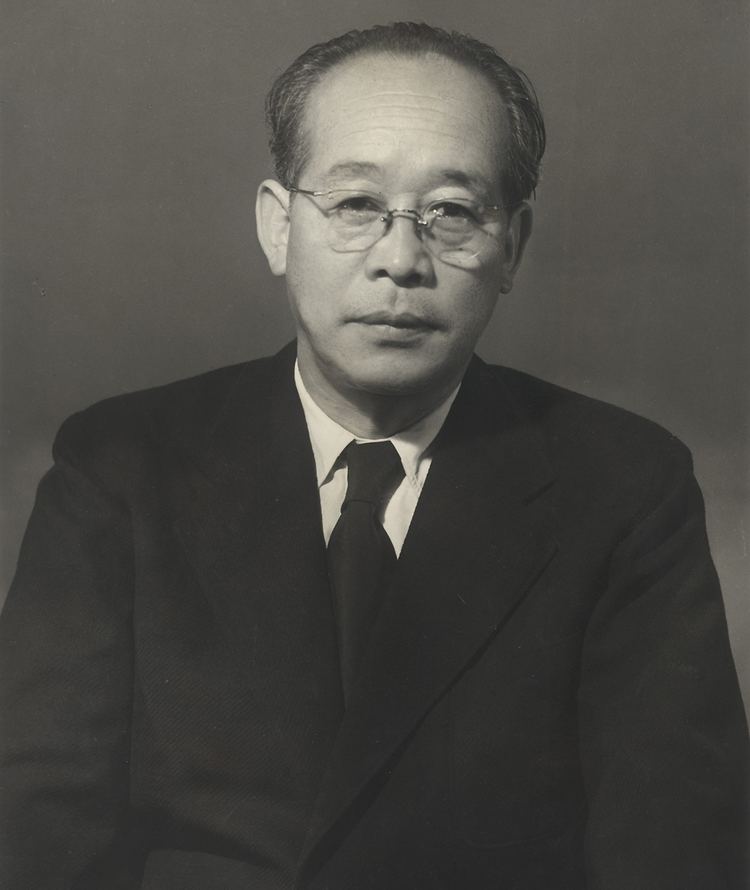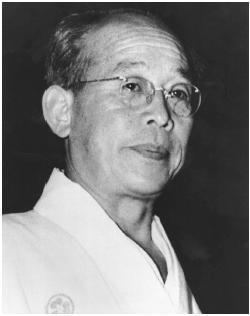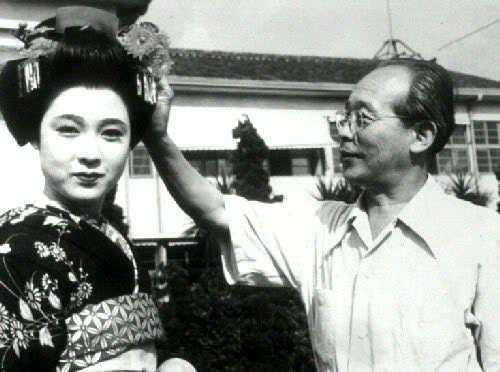Kenji Mizoguchi
4 /10 1 Votes
| ||||||||||||||||||||||||||||||||||
 | ||||||||||||||||||||||||||||||||||
Dance scene from tojin okichi okichi mistress of a foreigner dir kenji mizoguchi 1930
Kenji Mizoguchi (溝口 健二, Mizoguchi Kenji, May 16, 1898 – August 24, 1956) was a Japanese film director and screenwriter.
Contents
- Dance scene from tojin okichi okichi mistress of a foreigner dir kenji mizoguchi 1930
- Kenji mizoguchi the life of a film director clip
- Early years
- Film career
- Post war recognition
- Filmography
- UK and US
- Other
- References

Mizoguchi's work is renowned for its long takes and mise-en-scène. According to writer Mark Le Fanu, "His films have an extraordinary force and purity. They shake and move the viewer by the power, refinement and compassion with which they confront human suffering."

His film Ugetsu (1953) won the Silver Lion at the Venice Film Festival, and appeared in the Sight & Sound Critics' Top Ten Poll in 1962 and 1972. Other acclaimed films of his include The Story of the Last Chrysanthemums (1939), The Life of Oharu (1952), and Sansho the Bailiff (1954).

Kenji mizoguchi the life of a film director clip
Early years
Mizoguchi was born in Hongo, Tokyo, one of three children. His father was a roofing carpenter. The family was modestly middle-class until his father tried to make a living selling raincoats to soldiers during the Russo-Japanese war. The war ended too quickly for the investment to succeed; his family circumstances turned abject and they had to give his older sister up "for adoption" and moved from Hongo to Asakusa, near the theatre and brothel quarter. In effect his sister Suzuko, or Suzu, was sold into geishadom - an event which profoundly affected Mizoguchi's outlook on life. Between this and his father's brutal treatment of his mother and sister, he maintained a fierce resistance against his father throughout his life.
In 1911, Mizoguchi's parents, too poor to continue paying for their son's primary school training, sent him to stay with an uncle in Morioka, in northern Japan, for a year - a period that saw the onset of crippling rheumatoid arthritis that was to afflict him during adolescence and leave him with a lop-sided walking gait for the rest of his life. The year 1912, back with his parents, was spent almost entirely in bed. In 1913 Mizoguchi's sister Suzu secured him work as an apprentice, designing patterns for kimonos and yukatas. In 1915 his mother died, and Suzu brought her younger brothers into her own house and looked after them. In 1916 he enrolled for a course at the Aoibashi Yoga Kenkyuko art school in Tokyo, which taught Western painting techniques. At this time too he pursued a new interest in opera, particularly at the Royal Theatre at Akasaka where he began, in due course, to help the set decorators.
In 1917 his sister again helped him to find work, this time a post with the Yuishin Nippon newspaper in Kobe, as an advertisement designer. The writer Tadao Sato has pointed out a coincidence between Mizoguchi's life in his early years and the plots of shimpa dramas. Such works characteristically documented the sacrifices made by geishas on behalf of the young men they were involved with. Though Suzu was his sister and not a lover, "the subject of women's suffering is fundamental in all his work; while the sacrifice a sister makes for a brother - makes a key showing in a number of his films - Sansho Dayu for example." After less than a year in Kobe however he returned, "to the bohemian delights of Tokyo." Mizoguchi entered the Tokyo film industry as an actor in 1920; three years later he would become a full-fledged director, at the Nikkatsu studio, directing Ai-ni yomigaeru hi (The Resurrection of Love), his first movie, during a workers' strike.
Film career
Mizoguchi's early works had been exploratory, mainly genre works, remakes of German Expressionism and adaptions of Eugene O'Neill and Leo Tolstoy. In these early years Mizoguchi worked quickly, sometimes churning out a film in weeks. These would account for over fifty films from the 1920s and 1930s, the majority of which are now lost.
After the Great Kantō earthquake on September 1, 1923, Mizoguchi moved to Nikkatsu’s Kyoto studios and was working there until a scandal caused him to be temporarily suspended: Yuriko Ichijo, a call girl whom he was co-habiting with, attacked and wounded Mizoguchi's back with a razor-blade. "Working in Kyoto - the home of the traditional arts - had a decisive influence. Mizoguchi studied kabuki, noh, and traditional Japanese dance and music."
Several of Mizoguchi's later films were keikō-eiga or "tendency films," in which Mizoguchi first explored his socialist tendencies and moulded his famous signature preoccupations. Later in his life, Mizoguchi maintained that his career as a serious director did not begin until 1936, when Osaka Elegy and Sisters of the Gion were released.
In his middle films, Mizoguchi began to be hailed as a director of 'new realism': social documents of a Japan that was making its transition from feudalism into modernity. The Story of the Last Chrysanthemums (1939) won a prize with the Education Department; like the two above mentioned films, it explores the deprecatory role of women in an unfairly male-centered society. During this time, Mizoguchi also developed his signature "one-scene-one-shot" approach to cinema. The meticulousness and authenticity of his set designer Hiroshi Mizutani would contribute to Mizoguchi's frequent use of wide-angle lenses.
During the war, Mizoguchi was forced to make compromises for the military government as propaganda; the most famous is a retelling of the Samurai bushido classic The 47 Ronin (1941), an epic jidai geki ("historical drama").
Significant directors who have admired his work include Akira Kurosawa, Orson Welles, Masahiro Shinoda and Kaneto Shindo, Jean-Luc Godard, Andrei Tarkovsky, Jean-Marie Straub, Victor Erice, Jacques Rivette and Theo Angelopoulos.
Mizoguchi once served as president of the Directors Guild of Japan.
Post-war recognition
Immediately after the war, Mizoguchi's work, like that of his contemporary Yasujirō Ozu, was regarded by Japanese audiences as somewhat old-fashioned and dated. He was rediscovered, however, in the West - and particularly by Cahiers du cinéma critics such as Jacques Rivette. After a phase inspired by Japanese women's suffrage, which produced radical films like Victory of the Women (1946) and My Love Has Been Burning (1949), Mizoguchi took a turn to the jidai-geki — or period drama, re-made from stories from Japanese folklore or period history — together with long-time screenwriter and collaborator Yoshikata Yoda. It was to be his most celebrated series of works, including The Life of Oharu (1952), which won him international recognition and which he considered his best film, and Ugetsu (1953), which won the Silver Lion at the Venice Film Festival. Sansho the Bailiff (1954) reworks a premise from feudal Japan (and the short story by Mori Ōgai). Of his nearly 80 films, only two — Tales of the Taira Clan (1955) and Princess Yang Kwei-Fei (1955) — were made in colour.
Mizoguchi died in Kyoto of leukemia at the age of 58, by which time he had become recognized as one of the three masters of Japanese cinema, together with Yasujirō Ozu and Akira Kurosawa. At the time of his death, Mizoguchi was working on a film called Osaka Story. In all he made (according to his memory) about 75 films, although most of his early ones were lost. In 1975, Kaneto Shindo filmed a documentary about Mizoguchi, Kenji Mizoguchi: The Life of a Film Director, as well as writing a book published in 1976. A retrospective series of his 30 surviving films, sponsored by The Japan Foundation, toured several American cities in 2014.
